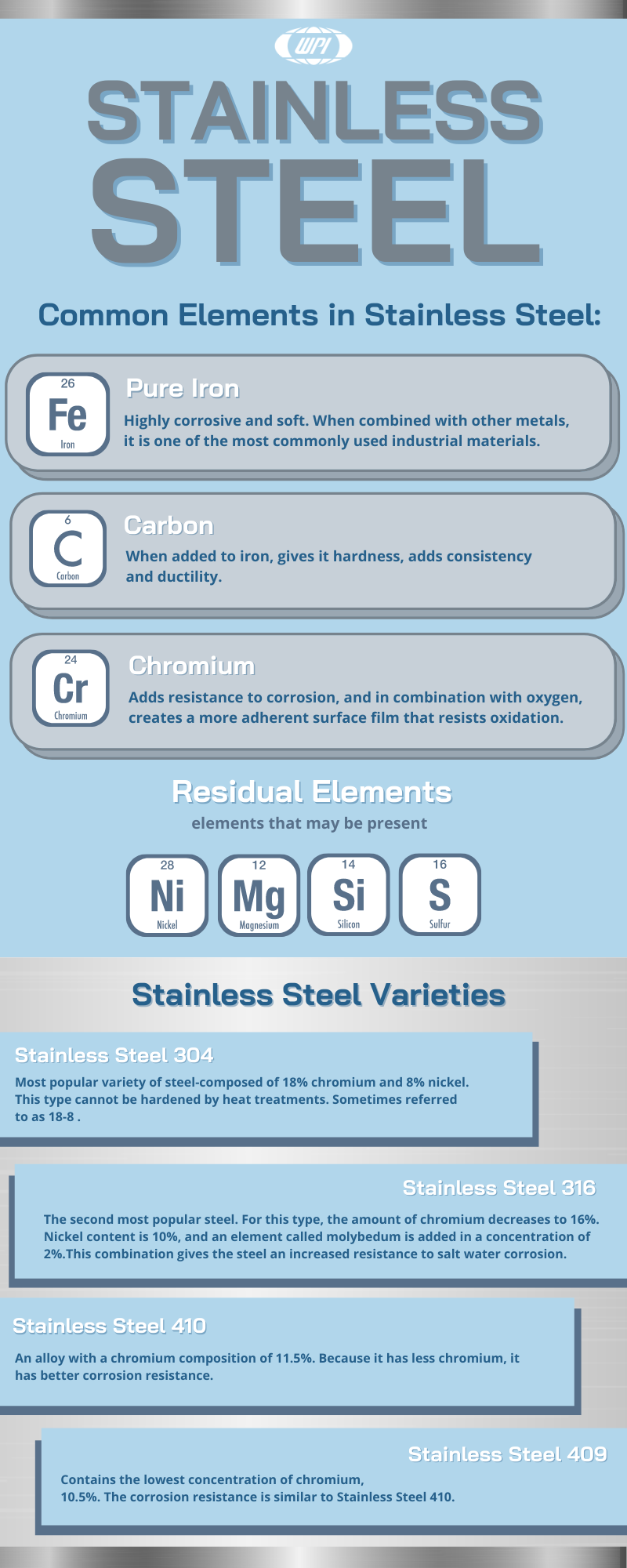Two main criteria to be considered when choosing your surgical instruments are the quality of the steel and the manufacturing process itself. Manufacturing quality instruments involves standards for various aspects of the manufacturing process, including the basic requirements for quality steel, as well as vigorous inspection for every step on the process. Here is a handy infographic comparing the various grades of stainless steel.
Stainless steel (Inox in Europe) is a mixture of metals, all playing different roles in the final alloy. Common elements found in steel composition includes:
- Pure Iron (Fe) is highly corrosive and soft, but when combined with other metals, it becomes by far one of the most commonly used industrial materials.
- Carbon added to the iron gives it hardness, adds consistency when the metal is welded and provides ductility. Ductility defines how a solid material stretches under tensile stress.
- Chromium adds resistance to corrosion, and in combination with the oxygen in the air, creates a more adherent surface film that resist further oxidation.
- Nickel, magnesium, silicon, molybedum and sulfur are called residual elements and are retained from the raw material. Unless the chemical composition of steel calls for a minimum or maximum of this elements, they may be present in the composition.
The degree to which the steel become “stainless” is determined by all these metals, by the heat treatment applied and by the final rinsing process. The additives increase the metal’s capacity to resist highly corrosive environments such as blood, body fluids, salt solutions, cleaning solutions and sterilization methods.
Based on the mechanical properties and composition, the American Iron and Steel Institute (AISI) differentiate all steel, about 80 types, by using 3-digits numbers. The most used types of steel, when making surgical instruments, are the 300 and 400 series described below . This types of steel is rust and corrosion resistant, has good tensile strength and will provide a sharp edge for repetitive use. The 300 series steels are manufactured from the austenic steel class and cannot be hardened by heat treatment. 400 series steels are manufactured from the martensenic steel class series and can be hardened by heat treatment.
- Stainless Steel 304 is the most popular variety of steel and is composed of 18% chromium and 8% nickel. This type cannot be hardened by heat treatments. Sometimes this steel is referred to as 18-8.
- Stainless Steel 316 is the second most popular steel. For this type, the amount of chromium decreases to 16%, the nickel content goes up to 10% and molybedum is added in a concentration of 2%.This combination gives the steel an increased resistance to salt water corrosion.
- Stainless Steel 410 is an alloy with a chromium composition of 11.5%. Because it has less chromium, it has better corrosion resistance.
- Stainless Steel 409 has the lowest concentration of chromium, 10.5%.The corrosion resistance is similar to Stainless Steel 410.
Mechanical Property of Stainless Steel Grades
| Stainless Grade | Hardness (Rb)1 | Tensile Strength (1000 psi)2 | Yield Strength (0.2% 1000 psi)3 | Elongation (% in 2”)4 |
| 304/316 | 78-83 | 80-85 | 30-42 | 50-60 |
| 430 | 80-85 | 70-75 | 40-50 | 30-35 |
| 410 | 80-82 | 70-75 | 34-45 | 25-35 |
| 409 | 75 | 65 | 35 | 25 |
1Rb is the abbreviation for Rockwell hardness measured in the B scale. The test is done by pressing a small indenter against a surface with a specific force.
2Tensile strength is the resistance of a material to a force tending to tear it apart. The unit of measure is PSI (pounds per square inch).
3The yield strength is the permanent deformation of a material when stress is applied.
4Elongation is a measure of the ductility of the steel, how far a material tested for tensile strength will elongate before a crack occurs.
Benefits of Stainless Steel
- Corrosion resistance (alkaline solution, chlorine, acids and water environments)
- High temperature resistance
- Easy to clean, making the best option in hospitals, clinics and laboratories
- Cost-effective
- 100% recyclable
Grades of Instruments
Surgical instruments come in three grades:
- Premium ore quality
- Intermediate ore quality
- Floor grade
Both premium and intermediate grade instruments are made out of corrosion resistant 300 and 400 steel and can withstand repetitive cutting or use, and repeated sterilization processes. They are manufactured to strict specifications and subjected to high quality control inspection at several points during the manufacturing process.
Floor grade instruments may look the same as the higher grades, but the specification for steel quality and manufacturing are less strict. Floor grade instruments are forged with recycled steel, and the finished product is plated to cover imperfections. These instruments can break more easily, and because they are plated, they can bend, and they rust relatively easily. This grade of instruments is designed for single use or as disposable instruments.
In order to avoid tissue damage, impaired healing or infection, good quality instrumentation should be used.
If you have questions regarding surgical instrument metals or grades, you can contact us






Request
Catalogue
Chat
Print